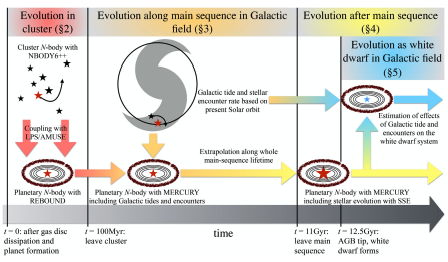Linking the formation and fate of exo-Kuiper belts within Solar system analogues
- 1Centre for Exoplanets and Habitability, University of Warwick, Coventry CV4 7AL, UK
- 2Department of Physics, University of Warwick, Coventry CV4 7AL, UK
- 3Astronomisches Rechen-Institut, Zentrum fu ̈r Astronomie der Universita ̈t Heidelberg, Mo ̈nchhofstr 12-14, D-69120 Heidelberg, Germany
- 4Department of Physics, School of Science, Xi’an Jiaotong-Liverpool University, 111 Ren’ai Rd., Suzhou Dushu Lake Science and Education Innovation District, Suzhou Industrial Park, Suzhou 215123, China
- 5Department of Mathematical Sciences, University of Liverpool, Liverpool L69 3BX, UK
- 6SURFsara, Science Park 140, NL-1098 XG Amsterdam, the Netherlands
- 7Leiden Observatory, Leiden University, PO Box 9513, RA Leiden NL-2300, the Netherlands
- 8Lund Observatory, Department of Astronomy & Theoretical Physics, Lund University, Box 43, SE-221 00 Lund, Sweden
- 9LESIA, Observatoire de Paris, Universite ́ PSL, CNRS, Sorbonne Universite ́, Universite ́ de Paris, 5 place Jules Janssen, F-92195 Meudon, France
- 10National Astronomical Observatories and Key Laboratory of Computational Astrophysics, Chinese Academy of Sciences, 20A Datun Rd., Chaoyang District, Beijing 100101, China
- 11Kavli Institute for Astronomy and Astrophysics, Peking University, Yiheyuan Lu 5, Haidian Qu, Beijing 100871, China
Escalating observations of exo-minor planets and their destroyed remnants both passing through the Solar system and within white dwarf planetary systems motivate an understanding of the orbital history and fate of exo-Kuiper belts and scattered discs.
Here, we explore how the structure of a 40-1000 au annulus of bodies (comets, planetesimals, asteroids) orbiting inside of a Solar system analogue that is itself initially embedded within a stellar cluster environment varies as the star evolves through all of its stellar phases. We attempt this computationally challenging link in four parts: (1) by performing stellar cluster simulations lasting 100 Myr, (2) by making assumptions about the subsequent quiescent 11 Gyr main-sequence evolution, (3) by performing simulations throughout the giant branch phases of evolution, and (4) by making assumptions about the belt's evolution during the white dwarf phase. Throughout these stages, we estimate the planetesimals' gravitational responses to analogues of the four Solar system giant planets, as well as to collisional grinding, Galactic tides, stellar flybys, and stellar radiation.
We find that the imprint of stellar cluster dynamics on the architecture of ≳100 km-sized exo-Kuiper belt planetesimals is retained throughout all phases of stellar evolution unless violent gravitational instabilities are triggered either (1) amongst the giant planets, or (2) due to a close (≪1000 au) stellar flyby. In the absence of these instabilities, these minor planets simply double their semimajor axis while retaining their primordial post-cluster eccentricity and inclination distributions, with implications for metal-polluted white dwarfs and the free-floating planetesimal population.

Caption: Cartoon describing how we modelled exo-Kuiper belts through all stages of evolution with different numerical codes and forces.
How to cite: Veras, D., Reichert, K., Flammini Dotti, F., Cai, M., Mustill, A., Shannon, A., McDonald, C., Portegies Zwart, S., Kouwenhoven, M., and Spurzem, R.: Linking the formation and fate of exo-Kuiper belts within Solar system analogues, Europlanet Science Congress 2020, online, 21 September–9 Oct 2020, EPSC2020-229, https://doi.org/10.5194/epsc2020-229, 2020

